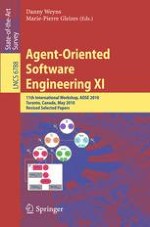Since the mid 1980s, software agents and multi-agent systems have grown into a very active area of research and also commercial development activity. One of the limiting factors in industry take-up of agent-technology, however, is the lack of adequate software engineering support. The Agent-Oriented Software Engineering Workshop, AOSE, focuses on the synergies and cross fertilization between software engineering and agent research.
This volume presents both thoroughly revised selected papers from the AOSE 2010 workshop held at AAMAS 2010 in Toronto, Canada in May 2010 as well as invited articles by leading researchers in the field. The papers cover a broad range of topics related to software engineering and agent-based systems, with particular attention to the integration of concepts and techniques from multi-agent systems with conventional engineering approaches on the one hand, and to the integration of agent-oriented software engineering and methodologies with conventional engineering processes on the other hand.
